The Turkish Republic of Northern Cyprus (or simply Northern Cyprus or North Cyprus) is a proclaimed in 1983, partially recognized state, occupying the northern third of Cyprus. Its population is approximately 200.000 people and the area is 3.355 sq. km. Northern Cyprus is separated from the rest part of Cyprus with a buffer zone. The line dividing the island into two sectors (the so-called "Green Line") is protected by the troops of the Armed Forces of the United Nations.
The picture depicts the administrative division of the Turkish Republic of Northern Cyprus (red), the Republic of Cyprus (blue), the UK military bases of Akrotiri and Dhekelia (dark blue) and the buffer security zone (light blue).
The environs of Kyrenia. The monument to Attila Operations (the entry of Turkish troops into Cyprus in 1974).
The monument is installed on the coast, a few miles far from Kyrenia.
And on the opposite side are only mountains and clouds...
Here you can often see the flags of Turkey and the Turkish Republic of Northern Cyprus demonstrating the ownership of these territories.
The nature of these places is very beautiful.
The north of Cyprus has magnificent beaches.
The architecture is quite monotonous. A mixture of the buildings of southern Cyprus and the Turkish style.
Many restaurants and cafes.
These are the residential areas of Famagusta city. The adjacent to them quarter is called Varosha and otherwise known as a "ghost city". Let us tell you why.
In 1970 Famagusta was a major tourist destination in Cyprus. In view of the increasing number of tourists there were built many new hotels and tourist sites (the greater part of them appeared in Varosha). From 1970 to 1974 the city was at the peak of its popularity. It was visited by many famous personages of that time. such as Elizabeth Taylor, Richard Burton, Raquel Welch and Brigitte Bardot.
But on July 20, 1974 the Turkish army invaded Cyprus (in response to the political upheaval in the country), and on August 15 of the same year occupied Famagusta. As a result, the country was split into two parts: Greek and Turkish. Living in Varosha Greeks were evacuated and since then have been prohibited to return (as well as whatever journalists). In this way, the quarter was frozen in time, with shops filled with clothes being fashionable 35 years ago, and empty but fully equipped hotels.
Since no repairs had been made over the long time, all buildings gradually became destroyed. The metal rusted, and numerous trees and other plants filled the streets...
It is surrounded only by such a fence with prohibiting billboards hanging on it.
The beach of Famagusta is the best in Cyprus - with fine sand and clear water. But, as you see, the beach is not crowded.
Photographing is forbidden here. The guards in the towers control all your movements.
Though, in some places the fence is low, and nobody is around. But we don't advise you to get there as, firstly, the territory of Varosha is still mined here and there and, secondly, the soldiers guarding the "city" are very determined. Seeing the offender, they won't probably comply with political correctness and diplomacy. Consequences can be extremely serious.
Varosha creates a sombre impression. The spirit of hopelessness hovers in the air and spreads all over Famagusta. The complete opposite of Kyrenia...
To change the mood, let's visit the main attraction of Famagusta, the Cathedral of St. Nicholas.
It's the main cathedral of the medieval city of Famagusta located on the eastern coast of Cyprus. It was built on the model of Reims Cathedral by Cypriot kings of the dynasty of Lusignan in the 14th century. The tourist brochures call it "the Cypriot Reims".
The cathedral was consecrated in 1328. Considerable damage to the building was caused by frequent earthquakes. In 1954 it was renamed the Lala Mustafa Pasha Mosque in honor of the captain who commanded the siege of Famagusta in 1571.






